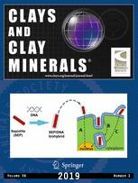Austin et al, 2020
Quantification of Mixed-Layer Clays in Multiple Saturation States Using NEWMOD2: Implications for the Potassium Uplift Hypothesis in the SE United States
Austin, J.C., Richter, D.D. & Schroeder, P.A. (2020)
Clays and Clay Minerals
-
Calhoun, INVESTIGATOR
-
Calhoun, INVESTIGATOR
-
Calhoun, INVESTIGATOR
Abstract
Quantification of mineral assemblages in near-surface Earth materials is a challenge because of the often abundant and highly variable crystalline and chemical nature of discrete clay minerals. Further adding to this challenge is the occurrence of mixed-layer clay minerals, which is complicated because of the numerous possible combinations of clay layer types, as defined by their relative proportions and the ordering schemes. The problem of ensuring accurate quantification is important to understanding landscape evolution because mineral abundances have a large influence on ecosystem function. X-ray diffraction analysis of the variable cation-saturated clay fraction in soil and regolith from the Calhoun Critical Zone observatory near Clinton, South Carolina, USA, was coupled with modeling using NEWMOD2 to show that mixed-layer clays are often dominant components in the mineral assemblages. Deep samples in the profile (>6.5 m) contain mixed-layer kaolinite/smectite, kaolinite/illite-like, kaolinite-vermiculite, illite-like/biotite, and illite-like/vermiculite species (with ‘illite-like’ defined herein as Fe-oxidized 2:1 layer structure with a negative layer charge of ~0.75 per unit formula, i.e. weathered biotite). The 2:1 layers in the mixed-layer structures are proposed to serve as exchange sites for K+, which is known to cycle seasonally between plant biomass and subsurface weathering horizons. Forested landscapes have a greater number of 2:1 layer types than cultivated landscapes. Of two nearby cultivated sites, the one higher in landscape position has fewer 2:1 layer types. Bulk potassium concentrations for the forested and two cultivated sites show the greatest abundances in the surface forested site and lowest abundance in the surface upland cultivated site. These observations suggest that landscape use and landscape position are factors controlling the mixed-layer mineral assemblages in Kanhapludults typical of the S.E. United States Piedmont. These mixed-layer clays are key components of the proposed mechanism for K+ uplift concepts, whereby subsurface cation storage may occur in the interlayer sites (with increased negative 2:1 layer charge) during wetter reduced conditions of the winter season and as biomass decay releases cation nutrients. Cation release from the mixed-layer clays (by decreased 2:1 layer charge) occurs under drier oxidized conditions during the growing seasons as biota utilize cation nutrients. The types and abundances of mixed layers also reflect long-term geologic factors including dissolution/alteration of primary feldspar and biotite and the subsequent transformation and dissolution/precipitation reactions that operate within the soil horizons. Thus, the resulting mixed-layer clay mineral assemblages are often complex and heterogeneous at every depth within a profile and across landscapes. X-ray diffraction (XRD) assessment, using multiple cation saturation state and modeling, is essential for quantifying the clay mineral assemblage and pools for cation nutrients, such as potassium, in the critical zone.
Citation
Austin, J.C., Richter, D.D. & Schroeder, P.A. (2020): Quantification of Mixed-Layer Clays in Multiple Saturation States Using NEWMOD2: Implications for the Potassium Uplift Hypothesis in the SE United States. Clays and Clay Minerals. DOI: 10.1007/s42860-019-00060-x
 This Paper/Book acknowledges NSF CZO grant support.
This Paper/Book acknowledges NSF CZO grant support.
Explore Further




